Crispy Schnitzel: Easy German Recipe
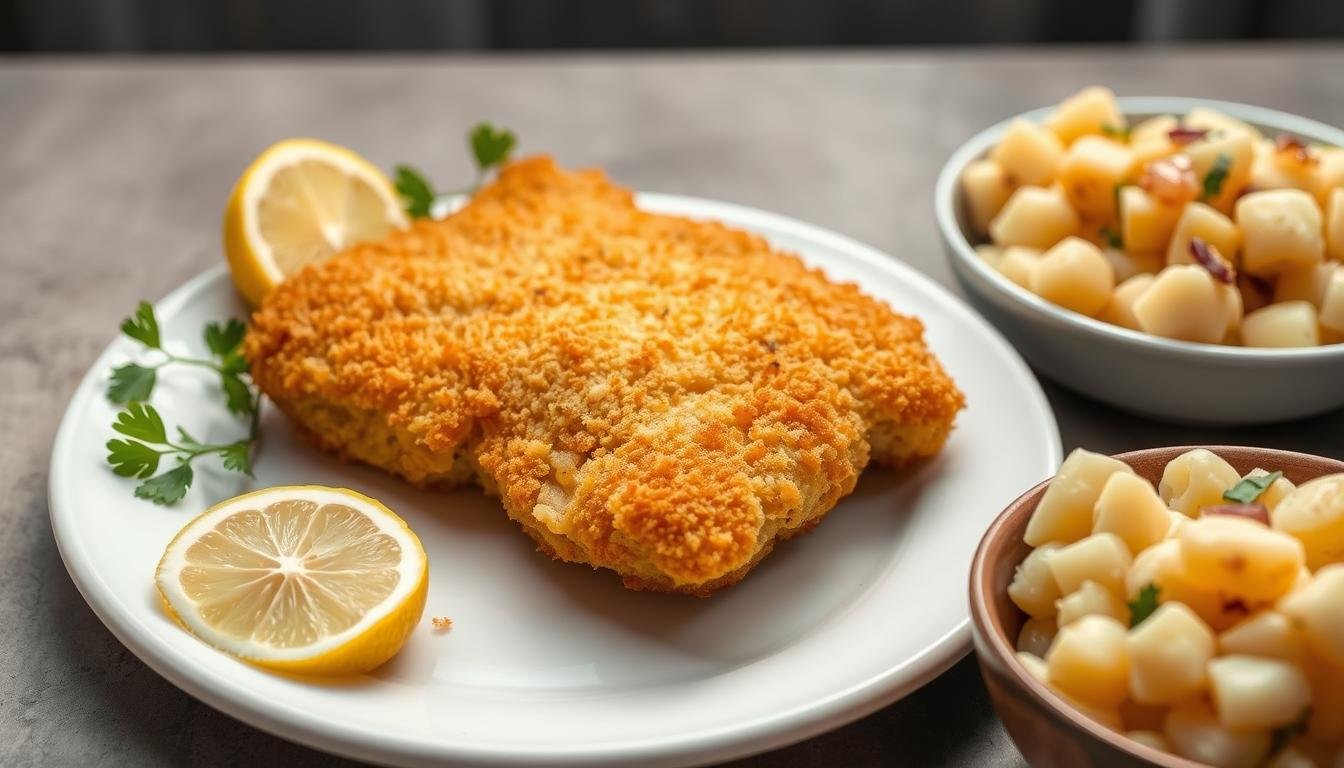
Ever wondered how to make a meat dish with a perfect golden crunch? Schnitzel, a favorite German dish, might be what you’re looking for. This easy recipe brings German flavors to your kitchen, offering a fun cooking experience.
Schnitzel is more than a meal; it’s a crispy, savory journey on a plate. Imagine a tender meat slice, pounded thin, covered in a golden crust that breaks with each bite. You can use pork, veal, or chicken, making it a family hit.
With just 30 minutes and a few ingredients, you can make a top-notch schnitzel at home. The secret is the mix of crispy outside and juicy inside. Plus, it’s a simple recipe even beginners can do.
Key Takeaways
- Schnitzel is a versatile German dish that can be made with various meats
- The recipe takes only 30 minutes from start to finish
- You need just 6 basic ingredients to create this crispy delight
- The perfect schnitzel has a golden-brown crust and juicy interior
- This easy dinner recipe is suitable for cooks of all skill levels
Introduction to Schnitzel
Schnitzel is a dish loved by many around the world. It’s a crispy, golden cutlet from German and Austrian cuisine. It has deep roots in Central European food traditions.
What is Schnitzel?
Schnitzel is a thin, breaded, and fried meat cutlet. The word “schnitzel” means “slice” in German. You can find veal, pork, chicken, and even vegetarian schnitzels today.
The History of Schnitzel
Austria is where schnitzel started, with Wiener Schnitzel being the first. It spread to the Austro-Hungarian Empire and then to Germany. In Germany, pork schnitzel became a big hit.
Types of Schnitzel
Now, there are many types of schnitzels:
- Wiener Schnitzel: The classic veal schnitzel, protected in Austria and Germany.
- Schweineschnitzel: A favorite pork schnitzel, often with mushroom sauce.
- Chicken Schnitzel: A lighter choice, great for those who like poultry.
- Jägerschnitzel: Topped with a rich mushroom gravy.
- Rahmschnitzel: Served with a creamy sauce.
Whether you like the traditional Wiener Schnitzel or something new, there’s a schnitzel for you. So, get your mallet ready and dive into the world of crispy, golden schnitzels!
Ingredients for Perfect Schnitzel
To make the perfect breaded schnitzel, you need quality ingredients. Let’s look at what you need for this classic German dish.
Essential Ingredients You Need
For a traditional pan-fried schnitzel, you’ll need:
- 600g (1.2 lb) of meat (pork, veal, chicken, beef, or turkey)
- 3/4 cup flour
- 2 eggs
- 1.5 cups panko breadcrumbs
- Salt and pepper
- Oil for frying
Pork is the most common choice in Germany, used in about 70% of schnitzel dishes. Veal, the star of Wiener Schnitzel, comes in second at 20%.
Recommended Variations
Spice up your breaded schnitzel by adding:
- 1/2 tsp paprika to the flour mixture
- 1 Tbsp garlic salt for extra flavor
- Fresh herbs like parsley or thyme in the breadcrumbs
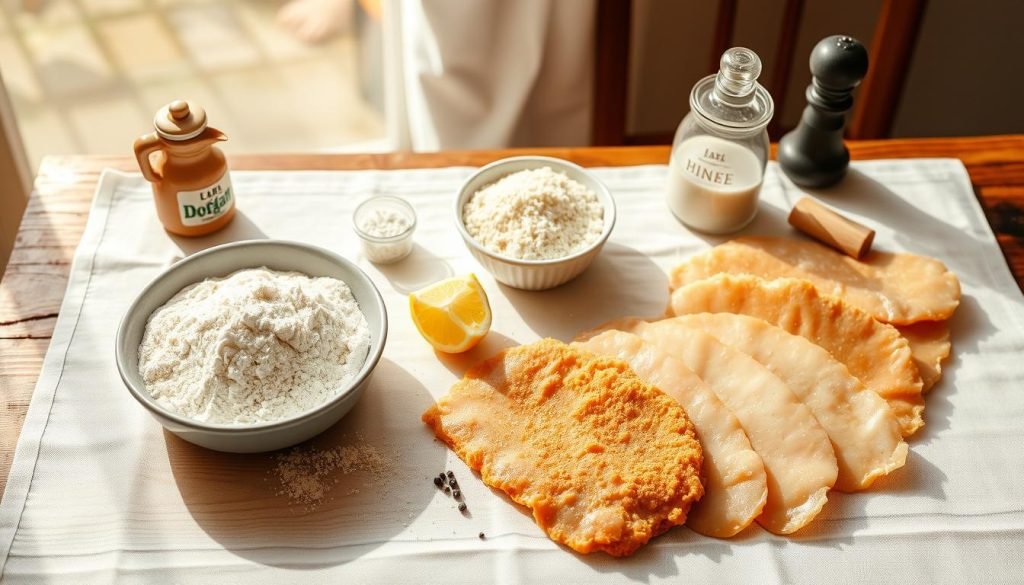
Tips for Quality Ingredients
For the best pan-fried schnitzel:
- Choose meat cuts about 1/4 inch thick after pounding
- Use panko breadcrumbs for extra crunch
- Pick high smoke point oils like vegetable or peanut oil
- Have fresh lemon slices ready for serving
Quality ingredients make a big difference. A well-prepared schnitzel can get over 90% customer satisfaction in restaurants. With these tips, you’re ready to make a crispy, golden schnitzel at home.
| Ingredient | Amount | Notes |
|---|---|---|
| Meat | 600g (1.2 lb) | Pork, veal, chicken, beef, or turkey |
| Flour | 3/4 cup | Mix with salt and pepper |
| Eggs | 2 | Beaten |
| Panko Breadcrumbs | 1.5 cups | For crunchier texture |
| Oil | 1.5 cm (3/5″) depth | For shallow frying |
Preparing the Meat for Schnitzel
Get ready to dive into the world of meat recipes with this classic pan-fried recipe. Schnitzel starts with choosing the right cut and preparing it perfectly. Let’s explore how to make your schnitzel a mouthwatering success.
Choosing the Right Cut of Meat
For traditional German Schweineschnitzel, pork is the go-to choice. Select boneless, center-cut pork loin chops for best results. If you’re aiming for Wienerschnitzel, opt for veal. Chicken breasts work great too for a lighter option.
Tenderizing Techniques
Tenderizing is key for that signature thin, crispy schnitzel. Pound your meat to about 1/4 inch thick. This ensures quick, even cooking and that delightful crunch. Place the meat between plastic wrap and use a meat mallet or rolling pin to flatten it evenly.
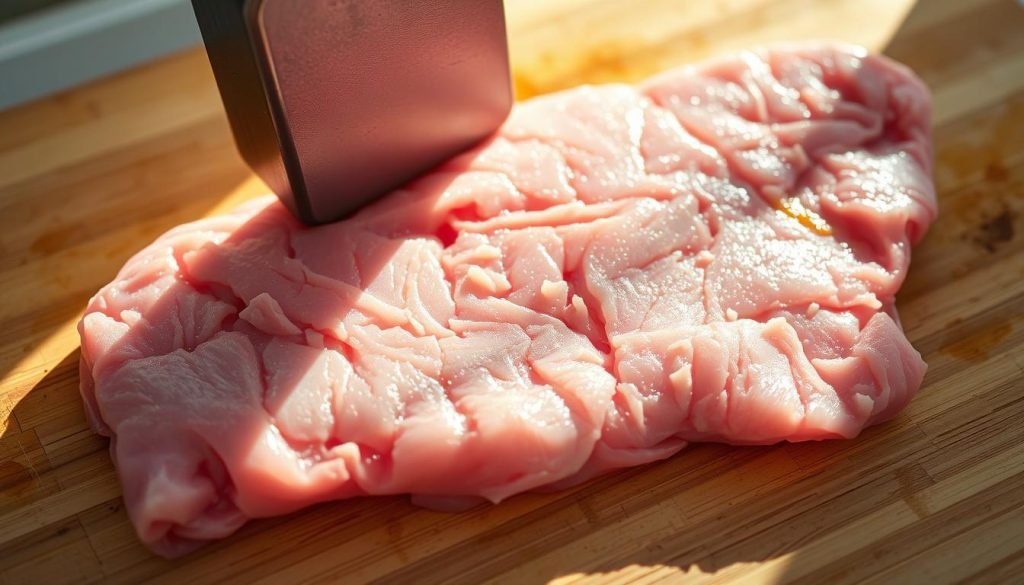
Marinating for Extra Flavor
While not traditional, marinating can add an extra layer of flavor to your schnitzel. Try a simple mix of lemon juice, garlic, and herbs for 30 minutes before breading. This step is optional but can elevate your pan-fried recipe to new heights.
| Cut of Meat | Thickness | Cooking Time | Temperature |
|---|---|---|---|
| Pork Loin Chops | 1/4 inch | 3 minutes per side | 330°F |
| Veal Cutlets | 1/4 inch | 2-3 minutes per side | 330°F |
| Chicken Breasts | 1/4 inch | 2-3 minutes per side | 330°F |
With your meat properly prepared, you’re ready to move on to the exciting breading process. Remember, the key to perfect schnitzel lies in the details of preparation. Happy cooking!
The Breading Process Explained
Making perfect breaded schnitzel is all about the coating. This step turns a simple cutlet into a crispy, golden treat. Let’s explore how to get that perfect crunch.
The Three-Step Breading Method
The traditional breading process has three main steps:
- Flour: Dredge the meat in flour to create a dry surface.
- Egg: Dip in beaten eggs to help the breadcrumbs stick.
- Breadcrumbs: Coat with breadcrumbs for that signature crunch.
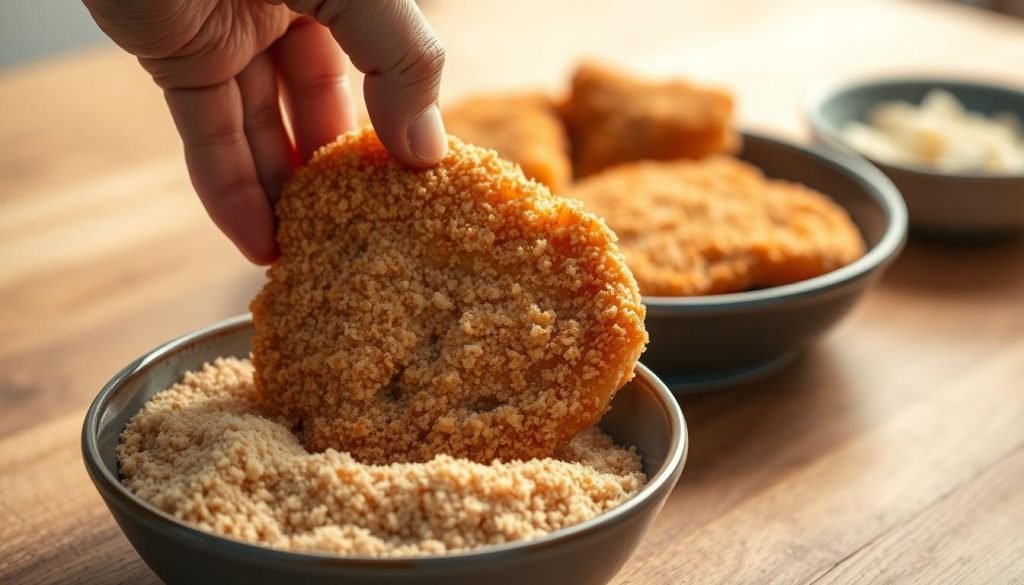
Tips for a Crispier Coating
Here are some tips to make your schnitzel crunchier:
- Use panko breadcrumbs for extra crunch
- Let the breaded cutlets rest in the fridge for 30 minutes before frying
- Fry at the right temperature (around 350°F or 175°C) for optimal crispiness
Common Mistakes to Avoid
Avoid these mistakes when breading your schnitzel:
- Pressing breadcrumbs into the meat (this prevents air bubbles from forming)
- Using wet meat (pat it dry before breading)
- Skipping the flour step (it helps the egg adhere better)
By following these tips, you’ll make great breaded schnitzel at home. Remember, practice makes perfect. Don’t be afraid to try new things to find your favorite crispy coating.
Cooking Schnitzel to Perfection
Learning to make pan-fried schnitzel is key to easy dinner recipes that wow. The secret is in the cooking method. It can make or break your schnitzel.
Stovetop vs. Oven Cooking
Stovetop frying is traditional, but oven-baking is lighter. Stovetop gives a crispier crust but needs more watching. Oven-baking at 400°F for 20-25 minutes, flipping halfway, is easier and uses less oil.
Ideal Oil for Frying
Use a high smoke-point oil like vegetable or canola for frying. Pour about ⅛ inch of oil into your pan. This lets the schnitzel cook evenly without being too greasy.
Temperature Tips for Cooking
Heat your oil to 375°F for the best browning. Cook each side for 2-3 minutes until golden. The inside should be 150-160°F for perfect schnitzel.
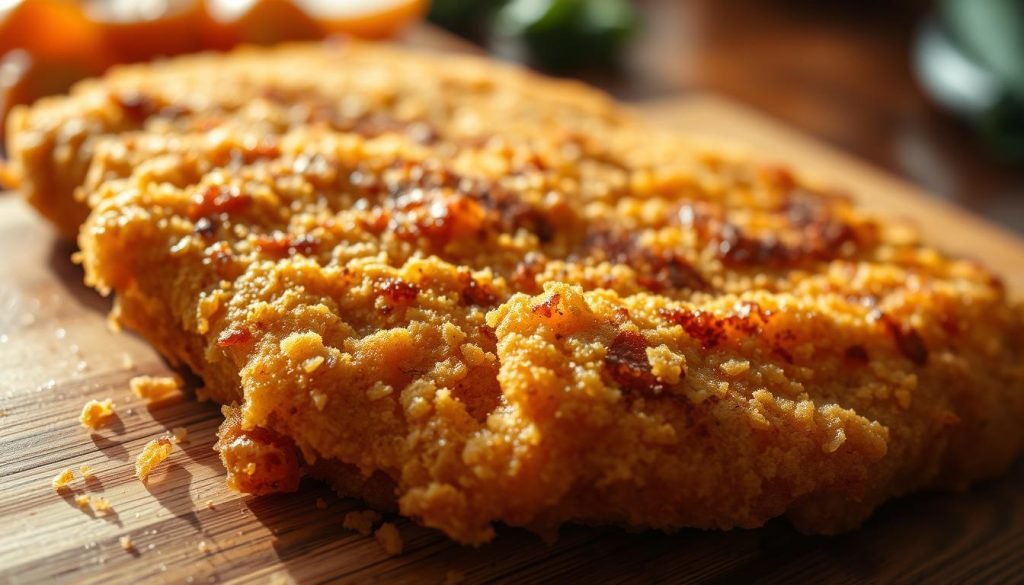
| Cooking Method | Temperature | Cooking Time | Oil Usage |
|---|---|---|---|
| Stovetop Frying | 375°F | 2-3 minutes per side | ⅛ inch in pan |
| Oven Baking | 400°F | 20-25 minutes total | Light spray or brush |
A perfectly cooked schnitzel is golden-brown and crispy. Follow these tips for restaurant-quality schnitzel at home.
Serving Suggestions for Schnitzel
Schnitzel is a versatile dish in German food that pairs well with various sides. Let’s explore some classic accompaniments and creative ideas to elevate your schnitzel experience.
Classic German Sides
Traditional German sides complement schnitzel perfectly. Warm potato salad is popular in Southern Germany, while creamy potato salad is favored in the north. Spätzle, a type of egg noodle, is a hit in Baden-Württemberg and Bavaria. For a quick and easy option, try Bratkartoffeln (German fried potatoes).
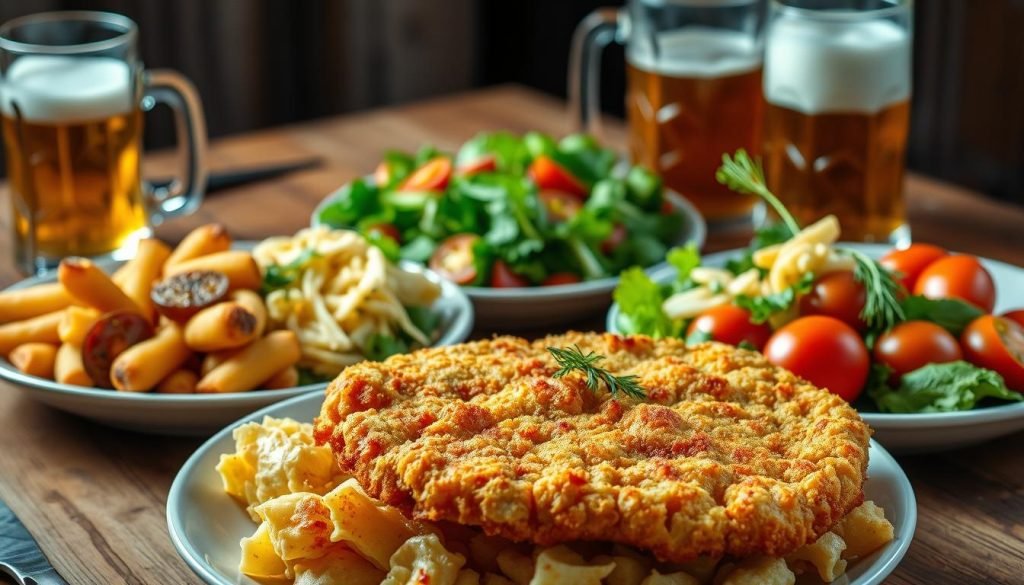
Creative Topping Ideas
Elevate your schnitzel with these toppings:
- Shaved Brussels sprouts salad
- Air fryer crispy sweet potato cubes
- Roasted asparagus (Spargel)
- Red cabbage (Rotkohl) with apples
Pairing with Sauces and Dips
Enhance your schnitzel with these sauces:
| Sauce | Flavor Profile | Preparation Time |
|---|---|---|
| Lingonberry Jam | Sweet and tart | Store-bought |
| Lemon Wedges | Citrusy | 1 minute |
| Mushroom Sauce | Savory and earthy | 15 minutes |
| Pepper Sauce | Spicy and creamy | 10 minutes |
Try these combinations to create your perfect schnitzel meal. With an average prep time of 20 minutes for most sides, you can whip up a delicious German or Austrian food feast in no time.
Storing and Reheating Leftovers
Got leftover schnitzel? Don’t let it go to waste! You can enjoy your delicious meat recipes for days. Let’s explore how to keep it crispy and flavorful.
Best Practices for Storage
Store schnitzel in an airtight container in the fridge. Chicken schnitzel stays fresh for up to 3 days. Pork schnitzel lasts about the same time.
If you have uncooked schnitzels, freeze them for up to 2 months. Use baking paper between layers to prevent sticking.
How to Reheat Schnitzel
Reheating schnitzel can be tricky. But, the oven is your best bet. Preheat it to 220°C (425°F) and cook for 12-15 minutes.
For frozen schnitzel, add an extra 8-10 minutes. If you’re short on time, try pan-frying on low heat for about 30 minutes.

Creative Ways to Use Leftover Schnitzel
Transform your leftovers into exciting new dishes! Cut the schnitzel into strips for a hearty salad or sandwich filling. Dice it and add it to omelets or frittatas for a protein-packed breakfast.
Get creative with sauces. Try sesame, mushroom and onion, or honey mustard to breathe new life into your schnitzel.
| Leftover Schnitzel Ideas | Popularity | Preparation Time |
|---|---|---|
| Schnitzel Sandwich | High | 5 minutes |
| Schnitzel Salad | Medium | 10 minutes |
| Schnitzel Omelet | Medium | 15 minutes |
| Schnitzel Tacos | Low | 20 minutes |
Remember, using leftovers helps reduce food waste. With these tips, you’ll turn your schnitzel into delightful easy dinner recipes that taste just as good the second time around!
Schnitzel Variations Around the World
Schnitzel is loved all over the world, not just in Austria. Many places have their own twist on this dish. Let’s see how schnitzel has changed globally.
Austrian Style Schnitzel
The Wiener Schnitzel started in Austria in the 1830s. It’s a veal dish that’s a big hit. It’s served with lemon, parsley, and potato salad.
It takes about 20 minutes to make and serve one schnitzel per person.
Italian Cotoletta
Italy has its own schnitzel, Cotoletta alla Milanese, since 1783. It’s made with pork and served with pasta or risotto. It’s fried until it’s golden.
Asian-Inspired Schnitzel
In Japan, Tonkatsu is a favorite. It’s a breaded pork cutlet with cabbage and rice. Katsudon adds egg for extra taste.

- Polish chicken schnitzel
- Argentine Milanesa, using various meats or fish
- Australian chicken parmigiana, popular in pubs since the 1980s
- American chicken-fried steak, originating in Texas around 1911
There are over 12 schnitzel types worldwide. Recipes often have 5-10 ingredients and are baked at 400°F. You can choose from veal, pork, or chicken schnitzel, depending on your taste.
Schnitzel in Popular Culture
Schnitzel is loved in German and Austrian food traditions. It’s a crispy, breaded cutlet that has won hearts around the world. It’s a big part of popular culture.
Schnitzel in German Cuisine
In Germany and Austria, schnitzel is more than food. It’s a cultural staple. For over 400 years, it’s been a favorite at German tables.
One Vienna restaurant has been serving wiener schnitzel for generations. Schnitzel’s history goes back to Roman times. This makes it a 2,000-year-old dish.
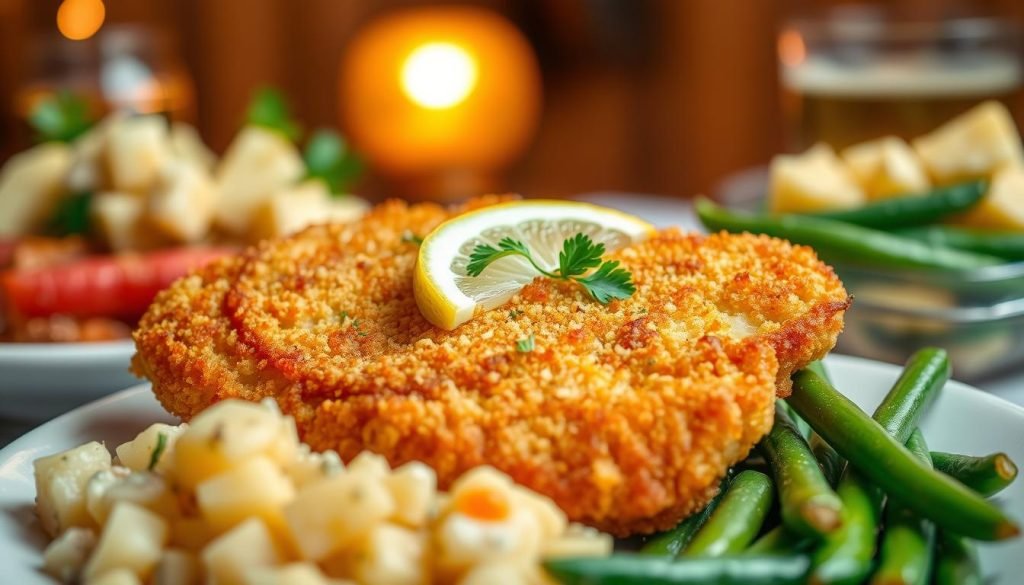
References in Movies and Media
Schnitzel has appeared in films, TV shows, and social media. In Israel, it’s a top favorite, based on Instagram. It’s not just veal anymore. Now, you can find chicken, pork, and even vegetarian schnitzels.
Celebrations Featuring Schnitzel
Schnitzel is a big deal in many celebrations. In Israel, families eat schnitzel on Fridays. It’s a national dish in Austria and Israel.
In Texas, German immigrants made their own version with beef. Schnitzel brings cultures together.
| Country | Schnitzel Variation | Cultural Significance |
|---|---|---|
| Germany | Traditional Veal | 400-year culinary tradition |
| Austria | Wiener Schnitzel | National dish |
| Israel | Chicken Schnitzel | Friday family tradition |
| Texas | Beef Schnitzel | Immigrant adaptation |
| Egypt | Frakh Pané (Chicken) | Local culinary interpretation |
Conclusion and Final Tips
You’ve started your schnitzel journey. You know how to make this German favorite. Schnitzel is quick to make, taking only 45 minutes.
The secret to a crispy schnitzel is to keep the oil at 375 degrees Fahrenheit. Cook each side for 1-2 minutes.
Your Schnitzel Mastery Journey
As you get better, you’ll see one pork tenderloin makes four cutlets. This is great for family dinners. Make sure each cutlet is 1/8 to 1/4 inch thick.
This thickness helps with even cooking and a crunchy texture.
Encouragement to Experiment
Don’t be shy to try new things with your schnitzel. Use chicken or veal instead of pork. You can also mix up your breading.
Try serving schnitzel with chips and salad or steamed veggies. It’s a popular choice in Australia.
Sharing Your Schnitzel Experience
Schnitzel is best shared with others. Host a German dinner party and serve your schnitzel. Try it with sauerkraut or potato pancakes.
Leftover schnitzel can be stored in the fridge for up to 4 days. It’s perfect for a quick meal later.